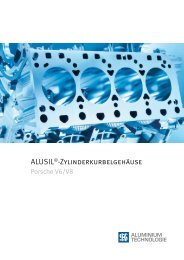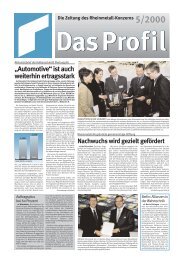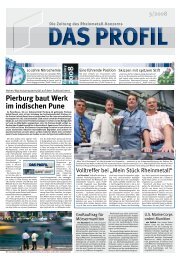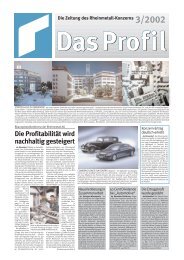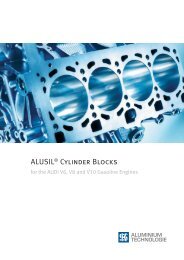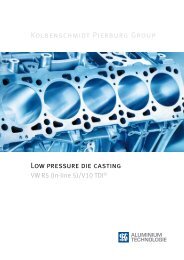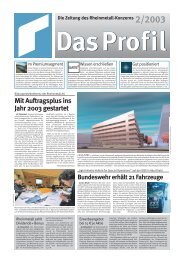PDF [1.1 MB] - KSPG AG
PDF [1.1 MB] - KSPG AG
PDF [1.1 MB] - KSPG AG
You also want an ePaper? Increase the reach of your titles
YUMPU automatically turns print PDFs into web optimized ePapers that Google loves.
Rheinmetall in Düsseldorf and has<br />
overseen the Puma project for the past<br />
three years.<br />
The objective was to create a vehicle<br />
capable not only of keeping up with<br />
the Leopard 2 main battle tank at<br />
home, but of being airlifted to remote<br />
areas of operation – ideally in all climate<br />
zones. The bulk of development<br />
work took place at PSM’s parent companies<br />
– RLS and KMW – who assigned<br />
some 200 developers to the<br />
project. Equipping the Puma with an<br />
entirely new protection concept was a<br />
prime objective. “We aimed to create<br />
space for a nine-man crew, with maximum<br />
protection from landmines and<br />
rocket propelled grenades”, stresses<br />
Peter Hellmeister.<br />
This led to the novel idea of placing<br />
the crew in the chassis. “Because the<br />
turret has to be remotely controlled”, explains<br />
Hellmeister, “the infantry squad<br />
isn’t separated from the turret crew.” As<br />
a result, only the one compact compartment<br />
requires maximum protection.<br />
Moreover, this eliminates the dead<br />
space that naturally occurs when a<br />
round turret is placed on a rectangular<br />
vehicle. Importantly, nobody sits in the<br />
turret, the most exposed and vulnerable<br />
part of an armored vehicle. These fundamental<br />
concepts ensure a high de-<br />
gree of passive protection, especially<br />
since the entire crew in the fighting compartment<br />
can maintain visual contact at<br />
all times, fostering clear communication<br />
– a crucial factor in combat.<br />
“We’re also setting new standards<br />
when it comes to the power pack,”<br />
states Hellmeister, a nuclear physicist<br />
by training. The problem is simple: the<br />
bigger the engine, the greater the space<br />
requirement and the heavier the vehi-<br />
Newsline<br />
Germany’s biggest procurement project right on schedule<br />
The Puma IFV is ready to pounce<br />
(Continued from page 6)<br />
cle, inevitably leading to a decline in<br />
the power-to-weight ratio – something<br />
of a vicious circle. Compared with analogous<br />
engines, however, the Puma’s<br />
power pack is significantly smaller and<br />
lighter. The power pack fills up 92 percent<br />
of the forward area of the vehicle, a<br />
triumph of space economy.<br />
The Puma’s pioneering anti-landmine<br />
protection also merits special<br />
attention. The double-layered<br />
floor of the vehicle is specifically<br />
designed to absorb the shockwave<br />
from an explosive blast. As<br />
Hellmeister explains, “The shockwave<br />
doesn’t reach the crew, because<br />
the inner floor is designed<br />
to give the lower floor sufficient<br />
room to move in the event of a detonation.”<br />
This effectively thwarts<br />
the physics of an explosive blast.<br />
A glance at the interior of the<br />
demonstrator vehicle reveals an<br />
added force protection feature:<br />
the crew sit on nylon slings rather<br />
than floor-mounted seats.<br />
This kind of passive force protection<br />
thinking extends to every component<br />
in the IFV. The automatic turret naturally<br />
contains the ammunition supply,<br />
which reaches the Puma’s twin guns<br />
via an ammunition feeding system. “If<br />
the turret takes a hit and its armor is<br />
penetrated, the ammunition stored<br />
there burns off, damaging the turret<br />
but not the fighting compartment. The<br />
crew remains unharmed, because the<br />
two parts of the vehicle are completely<br />
separate”, explains Peter Hellmeister,<br />
highlighting one of the Puma’s key<br />
safety features.<br />
7<br />
The new IFV’s running gear goes a<br />
long way in reducing physical strain on<br />
the crew during operation: it is effectively<br />
decoupled from the hull, to<br />
which it is linked by elastic connectors.<br />
Just as in standard automotive<br />
applications, hydropneumatic suspension<br />
elements serve as shock absorbers<br />
– a novel development in armored<br />
vehicle engineering. This lowers<br />
the noise level in the Puma to 95<br />
decibels, significantly less than the<br />
120 decibels typical in such vehicles<br />
today. “Since the decibel scale is logarithmic,<br />
for the troops this means a<br />
90% reduction in audible noise and vibration<br />
in the vehicle,” declares<br />
Hellmeister, noting that this translates<br />
into less stress during operations. “It’s<br />
important to remember that we’re talking<br />
about the soldiers’ workplace<br />
here”, points out the PSM managing<br />
director.<br />
The running gear also fits nicely into<br />
the underlying concept of passive safety.<br />
Because the torsion bar suspension<br />
typical in tanks is dispensed with in the<br />
Puma, the empty space above the lower<br />
floor (which a mine blast explosively<br />
deforms and pushes toward the fighting<br />
compartment) can be reduced. A<br />
further special feature: the running<br />
gear supports are hollow. Not only<br />
does this save weight, it creates space<br />
for fuel tanks, which are located in var-<br />
Set to roll of in December 2005: The Puma IFV is the German military’s largest, most important procurement project at present.<br />
ious compartments in the two running<br />
gear supports. Here, too, “safety first”<br />
is the watchword: if one of the storage<br />
tanks is damaged and the fuel catches<br />
fire, it burns outside of the fighting<br />
compartment, posing no danger to the<br />
crew. If worse comes to worse, the IFV’s<br />
fuel supply system can switch to emergency<br />
operating mode, providing the<br />
Puma with an adequate degree of mobility.<br />
(Continued on page 8)<br />
Composing: René Dahlmanns


![PDF [1.1 MB] - KSPG AG](https://img.yumpu.com/4218345/7/500x640/pdf-11-mb-kspg-ag.jpg)
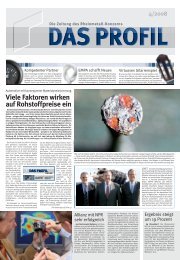
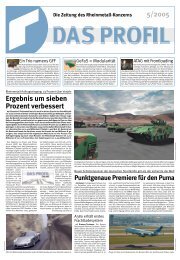
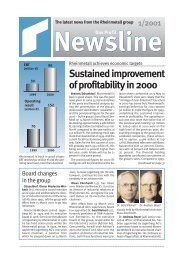

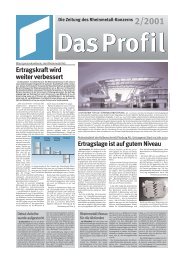
![PDF [1.0 MB] - KSPG AG](https://img.yumpu.com/5513074/1/171x260/pdf-10-mb-kspg-ag.jpg?quality=85)
